| Srl | Item |
| 1 |
ID:
164652
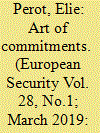

|
|
|
|
|
| Summary/Abstract |
Law and politics are the two constituent parts of a collective defence architecture. In Europe, such an architecture currently rests on a series of legal commitments: NATO’s mutual defence clause (Art.5 of the North Atlantic Treaty), but also the EU mutual assistance clause (Art.42.7 TEU) and the EU solidarity clause (Art.222 TFEU). Many asymmetries exist, however, between those legal clauses: they are often overlapping but not always identical with respect to their respective conditions of activation, territorial scopes, binding strengths, and modalities of implementation. Because of those legal asymmetries as well as prevailing political realities, there are many obstacles in fact to a clear-cut division of labour within Europe’s collective defence architecture between NATO and the EU. In Europe, collective defence should thus not be apprehended as a uniform task but rather as the art of balancing multiple legal and political constrains, come what may.
|
|
|
|
|
|
|
|
|
|
|
|
|
|
|
|
| 2 |
ID:
133366


|
|
|
|
|
| Publication |
2014.
|
| Summary/Abstract |
Two years ago, at our NATO Summit in Chicago. NATO leaders endorsed the review of NATO's deterrence and defence posture (D&DP).
|
|
|
|
|
|
|
|
|
|
|
|
|
|
|
|
| 3 |
ID:
134099
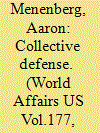

|
|
|
|
|
| Publication |
2014.
|
| Summary/Abstract |
Since the end of World War II, Japan has relied on the United States for its security, an arrangement enshrined in the US-written Japanese Constitution of 1947 and augmented by subsequent agreements between the two allies. Article IX of the Constitution prohibits Japan from taking part in any conflict or building a traditional military. (When President George H.?W. Bush organized the "coalition of the willing" against Iraq in 1991, Japan was able only to offer financial assistance because of this stipulation.) But with the rise of China and its assertion of sovereignty in regions Japan claims as its own, Tokyo has begun to expand its military capability. Some government officials wonder how these moves will affect relations with the United States, Japan's protector for the last half-century.
|
|
|
|
|
|
|
|
|
|
|
|
|
|
|
|
| 4 |
ID:
178083
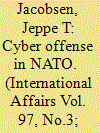

|
|
|
|
|
| Summary/Abstract |
As a response to the Russian invasion of Crimea, NATO returned to the core military concepts of deterrence and collective defence. This NATO adaption has recently come to include attempts to integrate offensive cyber effects into NATO force structure and response doctrine. The article argues—counter to what is publicly declared—that such an integration does little to strengthen NATO's deterrence posture and is unlikely to deter non-military, hybrid cyber activity below the threshold of collective defence. The article identifies several practical challenges to the current integration effort, which include the temporal dimension of developing exploits, battle damage assessment and deconfliction. With these challenges in mind, the article suggests that deploying minor and less resourceful cyber effects that cause persistent ‘cyber annoyances’ holds an unappreciated potential as they can drain opponent resources, disturb vital IT-systems and complicate decision-making. The article ends by arguing that NATO should not adapt its collective defence clause to cyberspace. A more active NATO in cyberspace risks undermining the cyber-intelligence norm that so far has prevented escalation and thereby increasing the likelihood that Russia misinterprets intelligence and active cyber defence activities as military preparation, armament or an attack in the making.
|
|
|
|
|
|
|
|
|
|
|
|
|
|
|
|
| 5 |
ID:
021554
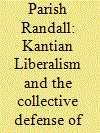

|
|
|
|
|
| Publication |
March 2002.
|
| Description |
228-250
|
|
|
|
|
|
|
|
|
|
|
|
|
|
|
|
| 6 |
ID:
151905
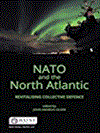

|
|
|
|
|
| Publication |
Abingdon, RUSI, 2017.
|
| Description |
xii, 106p.pbk
|
| Standard Number |
9781138079618
|
|
|
|
|
|
|
|
|
|
|
|
Copies: C:1/I:0,R:0,Q:0
Circulation
| Accession# | Call# | Current Location | Status | Policy | Location |
| 058973 | 355.031091821/OLS 058973 | Main | On Shelf | General | |
|
|
|
|
| 7 |
ID:
181192
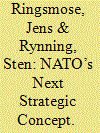

|
|
|
|
|
| Summary/Abstract |
NATO has embarked on the renewal of its Strategic Concept, the latest version of which dates to 2010. The question is whether this opportunity for renewal will result in a broad and elastic set of core tasks that have wide political appeal but that are ill suited to meet NATO’s strategic challenges. The Alliance opted for political convenience in 2010, and since then the complexity of Alliance politics has only increased. Allowing political considerations to dictate the contents of the new Strategic Concept would, however, bode ill for NATO’s ability to manage not only great-power competition but also an internal political–military divide that has become increasingly visible as NATO has adapted to Russia’s post-2014 revisionism. NATO’s next Strategic Concept should therefore put collective defence at the top of its list of priorities, reinvigorate NATO’s narrative of values, and encourage enhanced and sustained in-house political–military dialogue.
|
|
|
|
|
|
|
|
|
|
|
|
|
|
|
|
| 8 |
ID:
172011
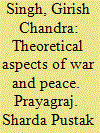

|
|
|
|
|
| Publication |
Prayagraj, Sharda Pustak Bhawan, 2020.
|
| Description |
xii, 395p.pbk
|
| Contents |
Book in Hindi Language.
|
| Standard Number |
9789387028159
|
|
|
|
|
|
|
|
|
|
|
|
Copies: C:1/I:0,R:0,Q:0
Circulation
| Accession# | Call# | Current Location | Status | Policy | Location |
| 059882 | 355.02/SIN 059882 | Main | On Shelf | General | |
|
|
|
|